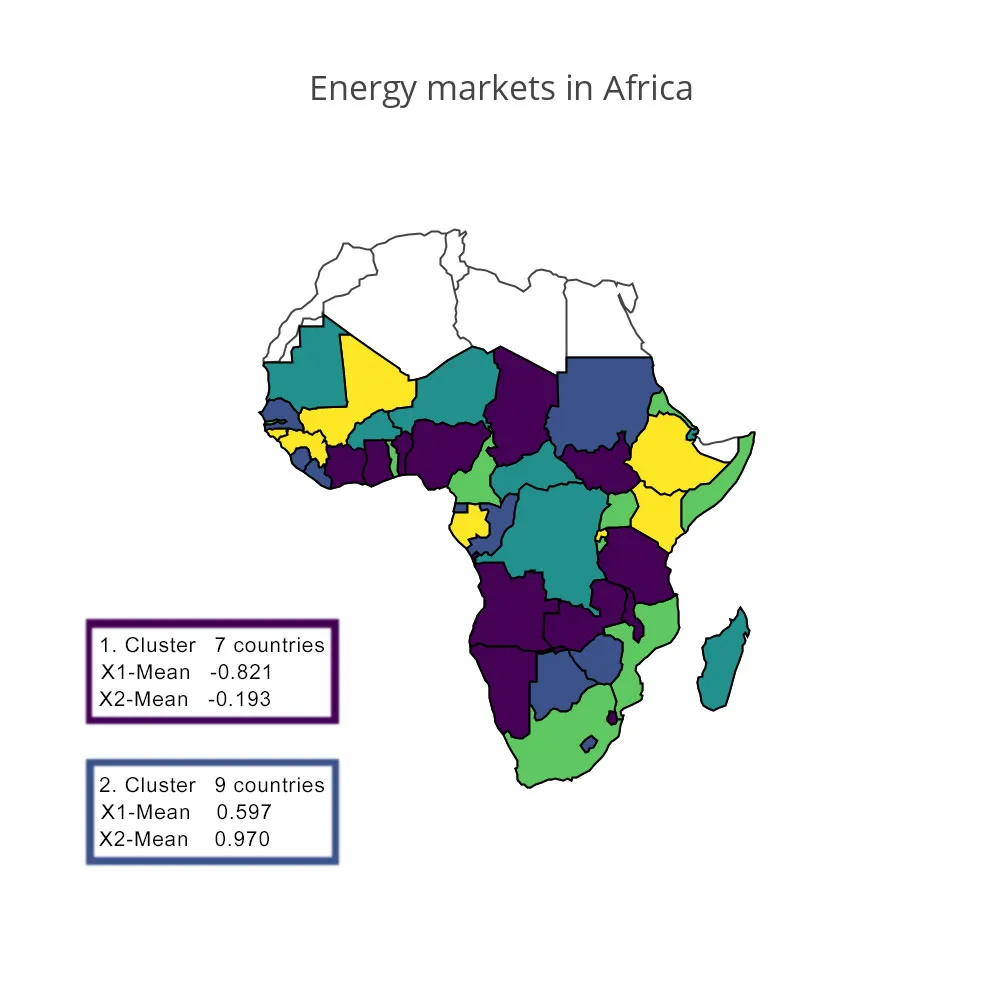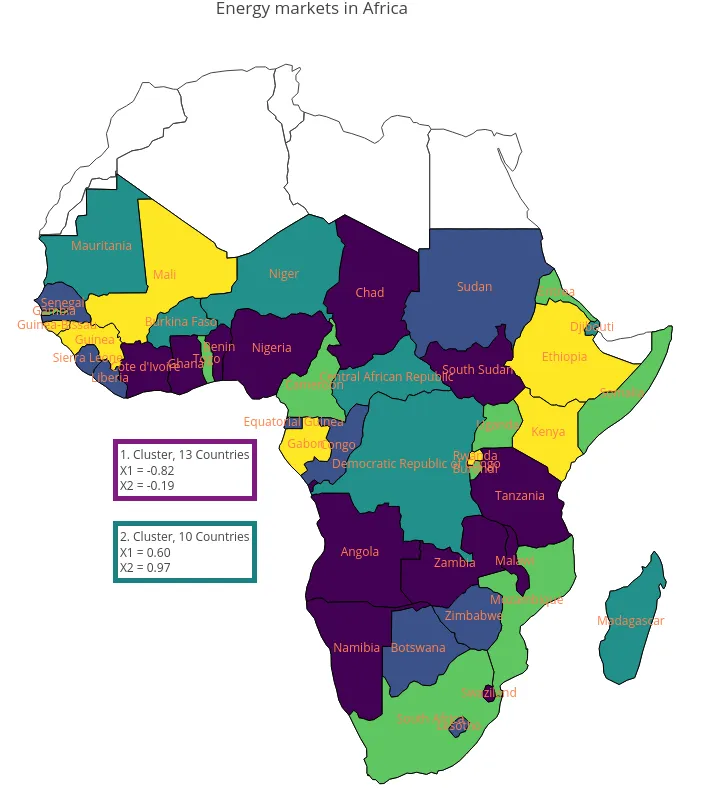以下代码根据层次聚类(使用
现在我想要更改两件事情:
hclust() 和 cutree())创建了一个区域地图(Choropleth map):library(plotly)
library(cluster)
hc <- hclust(dist(df), method = "complete")
df$member <- cutree(hc, 5)
cluster.means = (as.data.frame(aggregate(df[,-1], list(cluster= df$member), mean)))[,-4]
g = list(
scope = 'africa',
showframe = T,
showland = T,
landcolor = toRGB("white")
)
plot_ly(df, z = member, type = 'choropleth', locations = Country,
locationmode = 'country names', text = Country, hoverinfo = "text") %>%
layout(geo = g, title = "Energy markets in Africa")
现在我想要更改两件事情:
- 永久显示国家名称,即不仅在RStudio中悬停在交互式图表上时才显示。我尝试应用这篇文章的答案到我的代码中,但没有成功。
- 非连续比例尺。理想情况下,我希望完全没有比例尺,但是有5个盒子,每个盒子对应一个簇,具有以下三个特征:
(1) 盒子的颜色应该与其在区域分布图中的颜色相对应
(2) 每个盒子应包含分配给它的国家数量,即相应的簇
(3) 每个盒子应包含两个变量(X1,X2)的相应簇均值,这些变量包含在
cluster.means中
我已经附上了一个这样的示例图,展示了我所想要的内容(它不必完全相同,只需传达思想即可)。
任何帮助、建议、提示都会受到高度赞赏!
(缩放后)数据如下:
df <- structure(list(Country = structure(1:50, .Label = c("Angola",
"Benin", "Botswana", "Burkina Faso", "Burundi", "Cabo Verde",
"Cameroon", "Central African Republic", "Chad", "Comoros", "Congo",
"Cote d'Ivoire", "Democratic Republic of Congo", "Djibouti",
"Equatorial Guinea", "Eritrea", "Ethiopia", "Gabon", "Gambia",
"Ghana", "Guinea", "Guinea-Bissau", "Kenya", "Lesotho", "Liberia",
"Madagascar", "Malawi", "Mali", "Mauritania", "Mauritius", "Mozambique",
"Namibia", "Niger", "Nigeria", "Reunion", "Rwanda", "Sao Tome and Principe",
"Senegal", "Seychelles", "Sierra Leone", "Somalia", "South Africa",
"South Sudan", "Sudan", "Swaziland", "Tanzania", "Togo", "Uganda",
"Zambia", "Zimbabwe"), class = "factor"), X1 = c(-0.18, -1.03,
0.6, 1.55, 0.22, 0.26, 0.76, 2.15, -1.43, 0.99, 1.79, -0.39,
1.73, 1.57, 1.11, -0.09, -1.49, -0.46, -0.48, -1.22, -0.78, -1.46,
-1.22, 0.35, 0.45, 1.29, -1.37, -0.61, 0.92, -1.3, 0.42, -1.18,
1.4, -0.83, 0.06, -0.76, -0.19, -0.37, -0.63, 0.64, 0.93, 0.33,
-0.76, -0.21, -0.59, -0.41, -0.74, 0.39, -1.1, 1.35), X2 = c(-0.22,
-0.42, 0.72, -0.59, -1.27, 0.64, -1.35, -1.4, -0.35, -1.43, 1.07,
-0.01, -0.51, 0.11, 1.14, -0.89, 0.77, 1.45, -1.67, -0.83, 0.71,
0.92, 1.63, 1.68, 0.23, -0.18, 0.07, 0.8, -0.02, 0.82, -0.72,
-0.41, -0.26, 0.02, -1.68, 1.67, 0.18, 0.98, 1.45, 0.31, -1.23,
-1.38, -0.63, 1.41, -0.12, 0, -1.3, -1.64, 0.21, 1.52)), .Names = c("Country",
"X1", "X2"), row.names = c(NA, -50L), class = "data.frame")


y-value比上面小0.1。最后我会像这样将它们全部连接起来box = list(box1,box2,box3,box4,box5)并将box分配给annotations。但不幸的是,方框之间的距离不总是相同的...为什么? - Jonathan Rheinyanchor = "top"即可。我已经编辑了答案。 - dww